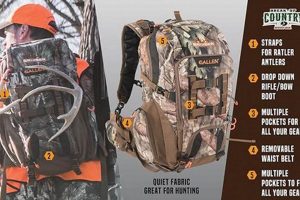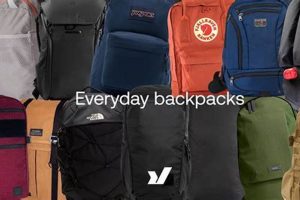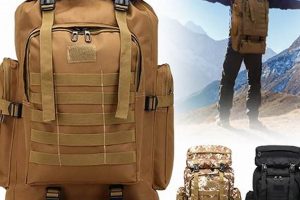Selection of load-carrying equipment designed to minimize stress on the spine is critical for individuals experiencing discomfort in the back. These specialized items prioritize ergonomic design and weight distribution to alleviate strain and promote proper posture. For example, backpacks featuring padded shoulder straps, sternum straps, and hip belts are frequently recommended to redistribute the load across the body, reducing pressure on the vertebral column.
The adoption of ergonomically sound carrying solutions offers multiple advantages, including reduced muscle fatigue, improved balance, and diminished risk of chronic back conditions. Historically, advancements in materials science and biomechanics have facilitated the development of increasingly effective load-bearing systems. The principles of proper load management can significantly impact overall physical well-being, particularly for individuals who regularly carry substantial weight.
The subsequent discussion will address key factors to consider when choosing load-carrying equipment to mitigate back discomfort. This includes examination of backpack features, appropriate fitting techniques, and strategies for optimizing load distribution to achieve maximum comfort and spinal health.
Guidance for Selecting Supportive Load-Carrying Equipment
The following recommendations offer practical advice for choosing load-carrying equipment designed to minimize back strain. Careful consideration of these factors can significantly improve comfort and reduce the risk of back pain aggravation.
Tip 1: Prioritize Ergonomic Design: Seek out backpacks with adjustable, padded shoulder straps, a sternum strap, and a well-padded hip belt. These features facilitate even weight distribution and minimize pressure points.
Tip 2: Evaluate Back Panel Support: Opt for a backpack featuring a structured back panel with ventilation channels. This promotes airflow and provides crucial lumbar support, maintaining proper spinal alignment.
Tip 3: Consider Backpack Weight: Prioritize lightweight materials to minimize the overall burden. An excessively heavy empty backpack will exacerbate existing back issues.
Tip 4: Assess Capacity Needs: Choose a backpack size appropriate for the typical load. Overpacking a smaller backpack can strain seams and compromise weight distribution.
Tip 5: Adjust Straps Properly: Ensure shoulder straps are snug but not overly tight. The hip belt should rest comfortably on the hips, bearing the majority of the weight.
Tip 6: Distribute Weight Evenly: Pack heavier items closer to the back to maintain balance and prevent forward leaning. Utilize internal compartments to stabilize the load.
Tip 7: Seek Professional Fitting: If possible, consult with a knowledgeable retailer for personalized fitting advice. A properly fitted backpack is essential for optimal comfort and support.
Adherence to these guidelines can substantially reduce the strain on the back associated with carrying loads. Prioritizing ergonomic features and proper fit are paramount for maintaining spinal health.
The subsequent section will explore specific backpack features and technologies designed to further enhance comfort and support for individuals experiencing back pain.
1. Ergonomic Design and Backpacks for Back Pain
Ergonomic design constitutes a fundamental element in load-carrying equipment intended to minimize back pain. The relationship between the two is causal: the features of a backpack directly affect the biomechanical stress placed upon the spine. Inadequate design can lead to improper posture, muscle imbalances, and exacerbated back discomfort. Conversely, a backpack integrating ergonomic principles effectively distributes weight, promotes spinal alignment, and reduces muscular strain.
A primary example of ergonomic design in action is the inclusion of adjustable, padded shoulder straps. These straps allow for a customized fit, ensuring the backpack sits comfortably against the user’s back without digging into the shoulders. Coupled with a sternum strap, these features prevent the backpack from swaying or pulling backward, maintaining a balanced center of gravity. Furthermore, a well-padded hip belt plays a critical role by transferring a significant portion of the load from the shoulders and spine to the stronger muscles of the hips and legs. The practical significance of this weight redistribution cannot be overstated; it directly mitigates the compressive forces acting on the vertebral discs, a key contributor to back pain.
In summary, ergonomic design is an indispensable component of any load-carrying solution intended to alleviate back discomfort. The integration of features such as adjustable straps, supportive back panels, and weight-distributing hip belts directly impacts the biomechanics of load carriage, reducing strain and promoting spinal health. While individual needs may vary, prioritizing ergonomic principles remains essential when selecting load-carrying equipment.
2. Weight distribution
Efficient weight distribution is a critical factor in mitigating back pain associated with load-carrying equipment. The manner in which weight is dispersed across the body significantly impacts spinal alignment, muscular strain, and overall comfort. Proper weight distribution minimizes stress on the vertebral column and reduces the risk of developing or exacerbating back problems.
- Hip Belt Engagement
A well-designed hip belt transfers a substantial portion of the load from the shoulders and spine to the hips and legs. This shift in weight-bearing responsibilities reduces compressive forces on the lumbar vertebrae, a common source of back pain. For instance, construction workers carrying heavy tools in a backpack rely heavily on hip belts to alleviate spinal strain. A properly fitted and engaged hip belt is essential for effective weight transfer.
- Sternum Strap Utilization
The sternum strap, while seemingly minor, plays a crucial role in stabilizing the backpack and preventing lateral sway. This stabilization minimizes the shifting of weight, reducing the need for compensatory muscle contractions in the back and shoulders. Backpackers traversing uneven terrain benefit from the enhanced stability provided by a sternum strap, reducing the risk of muscle fatigue and back strain.
- Load Placement Proximity
Positioning heavier items closer to the wearer’s back, specifically between the shoulder blades and lumbar region, maintains a more balanced center of gravity. This proximity minimizes the forward pull on the shoulders and reduces the strain on the spinal erectors. Students carrying heavy textbooks can reduce back strain by packing larger, heavier books closer to their back, rather than in the outer compartments of the backpack.
- Internal Compartmentalization
Internal compartments and dividers aid in preventing load shifting within the backpack. By securing items in place, these compartments ensure a more stable and predictable weight distribution. This stability minimizes the need for constant readjustments and reduces the risk of sudden, uneven weight shifts that can strain the back. Photographers carrying sensitive equipment in backpacks utilize internal dividers to prevent movement and maintain a balanced load, which is essential for comfort during extended periods of carrying.
The aforementioned facets of weight distribution are fundamental to the effectiveness of load-carrying equipment in mitigating back pain. A backpack that incorporates these design principles promotes proper posture, reduces muscular strain, and minimizes compressive forces on the spine. Prioritizing these elements when selecting a backpack is essential for individuals seeking to reduce or prevent back discomfort associated with carrying loads.
3. Adjustable support
Adjustable support is a critical characteristic of load-bearing equipment designed to mitigate back pain. The human torso exhibits considerable variation in size and shape. A static, non-adjustable backpack fails to accommodate these individual differences, resulting in uneven weight distribution, pressure points, and compromised spinal alignment. These factors can directly contribute to muscle strain, nerve compression, and the exacerbation of existing back conditions. Thus, the capacity for customizable support is fundamentally linked to the effectiveness of a backpack in alleviating discomfort.
The practical application of adjustable support manifests in several key features. Adjustable torso length allows the user to align the shoulder straps with the natural curvature of their back, ensuring that the load is borne vertically along the spine. Adjustable shoulder straps, sternum straps, and hip belts enable fine-tuning of the fit, preventing slippage and maximizing weight transfer to the stronger muscles of the hips and legs. Absence of these adjustable features requires the wearer to compensate through posture, creating strain points. For example, a delivery person with a static backpack might hunch forward, stressing the lumbar region. Conversely, an adjustable system allows for a customized fit, distributing the load efficiently and maintaining optimal posture.
In summary, adjustable support is not merely an optional feature; it is an essential component of load-bearing equipment intended to minimize back pain. It addresses the inherent variability of the human form, enabling proper weight distribution, spinal alignment, and muscular engagement. The absence of adjustable features compromises the ergonomic integrity of the backpack, potentially exacerbating back discomfort. Therefore, prioritizing adjustable support is paramount in the selection of load-carrying solutions designed to promote spinal health.
4. Appropriate capacity
The term “appropriate capacity,” when associated with load-carrying equipment designed to minimize back pain, denotes the volume of the backpack relative to the weight and nature of the intended contents. A direct correlation exists between inappropriate capacity and increased risk of back discomfort. Overloading a backpack, irrespective of its ergonomic features, places excessive stress on the musculoskeletal system. Conversely, utilizing an unnecessarily large backpack can encourage overpacking, leading to the same adverse outcome. Therefore, selecting a backpack with a capacity aligned with typical carrying needs is paramount.
An undersized backpack forces users to carry essential items externally or awkwardly distribute weight, compromising balance and posture. For instance, a student attempting to fit a large textbook into a small backpack may be compelled to carry additional books in their arms, creating an uneven load distribution and strain on the back. A backpack with excessive capacity, though not overloaded, can allow contents to shift during movement. This dynamic weight shift necessitates constant muscle engagement for stabilization, leading to fatigue and potential injury. Consider a hiker using a large-capacity daypack only partially filled; the shifting gear can disrupt balance on uneven terrain, increasing the risk of falls and back strain.
In conclusion, “appropriate capacity” represents an integral component of any load-carrying solution seeking to mitigate back pain. It requires careful consideration of the typical volume and weight of the carried items. An undersized or oversized backpack compromises weight distribution, postural alignment, and overall stability, thereby increasing the risk of back discomfort. Choosing a backpack with a capacity that aligns with actual needs, prevents both overloading and excessive space, significantly contributes to spinal health and comfort while carrying loads.
5. Durable materials
The selection of durable materials in load-carrying equipment directly influences its ability to mitigate back pain. Material integrity affects the backpack’s structural support, longevity, and ability to maintain consistent weight distribution. Compromised materials compromise ergonomic design and escalate strain on the spine.
- Abrasion Resistance and Structural Integrity
Materials resistant to abrasion maintain the backpack’s shape and prevent tearing, even under stress or contact with rough surfaces. Degraded materials lose their structural integrity, leading to sagging and uneven weight distribution. For instance, a backpack constructed with ballistic nylon retains its shape better than one made with standard polyester, ensuring consistent support and preventing the contents from shifting. This prevents the wearer from compensating with poor posture, reducing back strain.
- Water Resistance and Load Protection
Durable, water-resistant materials protect the contents from moisture damage, preventing added weight from water absorption. Wet gear is heavier gear, exacerbating back strain. Furthermore, materials like waterproof coated nylon prevent moisture from weakening the fabric itself. Consider a student’s backpack; durable, water-resistant materials keep books and electronics dry, preventing damage and avoiding the extra weight associated with waterlogged materials.
- Seam Strength and Component Integration
Durable threads and reinforced seams ensure components like straps, hip belts, and handles remain securely attached. Weak seams fail under stress, compromising the backpack’s load-bearing capacity and safety. A hiking backpack with reinforced stitching at stress points will maintain its structure even when fully loaded, preventing strap detachment and ensuring proper weight distribution. Compromised seams can lead to sudden shifts in weight and increased risk of injury.
- Material Longevity and Long-Term Support
Durable materials resist degradation from UV exposure, temperature fluctuations, and repeated use, extending the backpack’s lifespan and maintaining its supportive qualities over time. Inferior materials break down quickly, losing their shape and providing inadequate support. A backpack made from high-quality canvas, properly cared for, can last for years, providing consistent ergonomic support throughout its lifespan. Less durable materials require more frequent replacement, an added expense that also means repeatedly adjusting to new equipment.
In conclusion, material selection is a critical determinant in the overall effectiveness of load-carrying equipment for back pain mitigation. Durable materials ensure structural integrity, consistent weight distribution, and long-term support, preventing postural compensation and reducing strain on the spine. Choosing a backpack constructed from high-quality materials represents a long-term investment in spinal health and overall comfort.
Frequently Asked Questions
The following questions address common concerns regarding selecting and utilizing load-carrying equipment to mitigate back discomfort. The information provided is intended to offer practical guidance for individuals seeking to improve spinal health and reduce strain.
Question 1: Does the empty weight of a backpack significantly impact its suitability for individuals with back pain?
Yes, the empty weight of a backpack is a crucial consideration. An excessively heavy backpack, even before loading, contributes to overall strain on the back. Opting for lightweight materials minimizes the initial burden, reducing the risk of exacerbating existing back conditions.
Question 2: How important is the hip belt for effective weight distribution, and how should it be properly fitted?
The hip belt is paramount for efficient weight distribution, transferring a substantial portion of the load from the shoulders and spine to the hips and legs. It should be positioned comfortably on the iliac crest (hip bones), with the padded portions wrapping around the hips. The belt should be snug but not overly tight, allowing for free movement while effectively transferring weight.
Question 3: Are there specific backpack features designed to enhance lumbar support, and what should individuals look for?
Backpacks designed with integrated lumbar support often feature contoured back panels and internal frames that conform to the natural curvature of the spine. Individuals should seek out backpacks with adjustable lumbar pads or panels that can be positioned to provide targeted support to the lower back.
Question 4: How does the positioning of items within a backpack affect spinal strain, and what are the recommended packing strategies?
The positioning of items significantly impacts spinal strain. Heavier items should be packed closest to the back, between the shoulder blades and lumbar region, to maintain a balanced center of gravity. Lighter items can be placed further away. Utilize internal compartments to prevent shifting during movement.
Question 5: Can ill-fitting shoulder straps contribute to back pain, and what adjustments should be made to ensure proper fit?
Yes, ill-fitting shoulder straps can contribute to back pain by creating pressure points and uneven weight distribution. Shoulder straps should be adjusted to a snug but not overly tight fit, allowing for comfortable movement. The sternum strap should be utilized to prevent the shoulder straps from slipping off the shoulders and to maintain proper posture.
Question 6: What role does backpack material play in long-term support and comfort, and what materials are recommended?
Backpack material is crucial for long-term support and comfort. Durable, abrasion-resistant materials such as ballistic nylon and ripstop nylon maintain the backpack’s structural integrity and prevent sagging or tearing. Water-resistant coatings protect the contents from moisture and prevent added weight. These materials ensure consistent support and prevent postural compensation.
In summary, the selection and proper utilization of load-carrying equipment require careful consideration of factors such as empty weight, hip belt fit, lumbar support, packing strategies, shoulder strap adjustment, and material durability. Prioritizing these elements can significantly reduce the risk of back pain and promote spinal health.
The subsequent section will explore specific backpack models and brands recognized for their ergonomic design and features.
Concluding Remarks on Load-Carrying Equipment for Back Pain Mitigation
The preceding examination of “best backpacks for back pain” has underscored several critical considerations for individuals seeking to minimize spinal strain. Key factors include ergonomic design, efficient weight distribution, adjustable support, appropriate capacity, and durable materials. The absence of these features increases the risk of postural imbalance, muscle fatigue, and exacerbation of pre-existing back conditions. Prioritizing these attributes during the selection process represents a proactive step toward preserving spinal health.
The significance of appropriate load-carrying equipment extends beyond mere comfort; it directly impacts long-term musculoskeletal well-being. Continued advancements in materials science and biomechanical engineering offer the potential for further refinements in backpack design. Individuals should remain informed about emerging technologies and prioritize professional fitting to ensure optimal support and spinal alignment. This diligent approach contributes to a healthier, more active lifestyle and mitigates the pervasive impact of back pain on overall quality of life.







